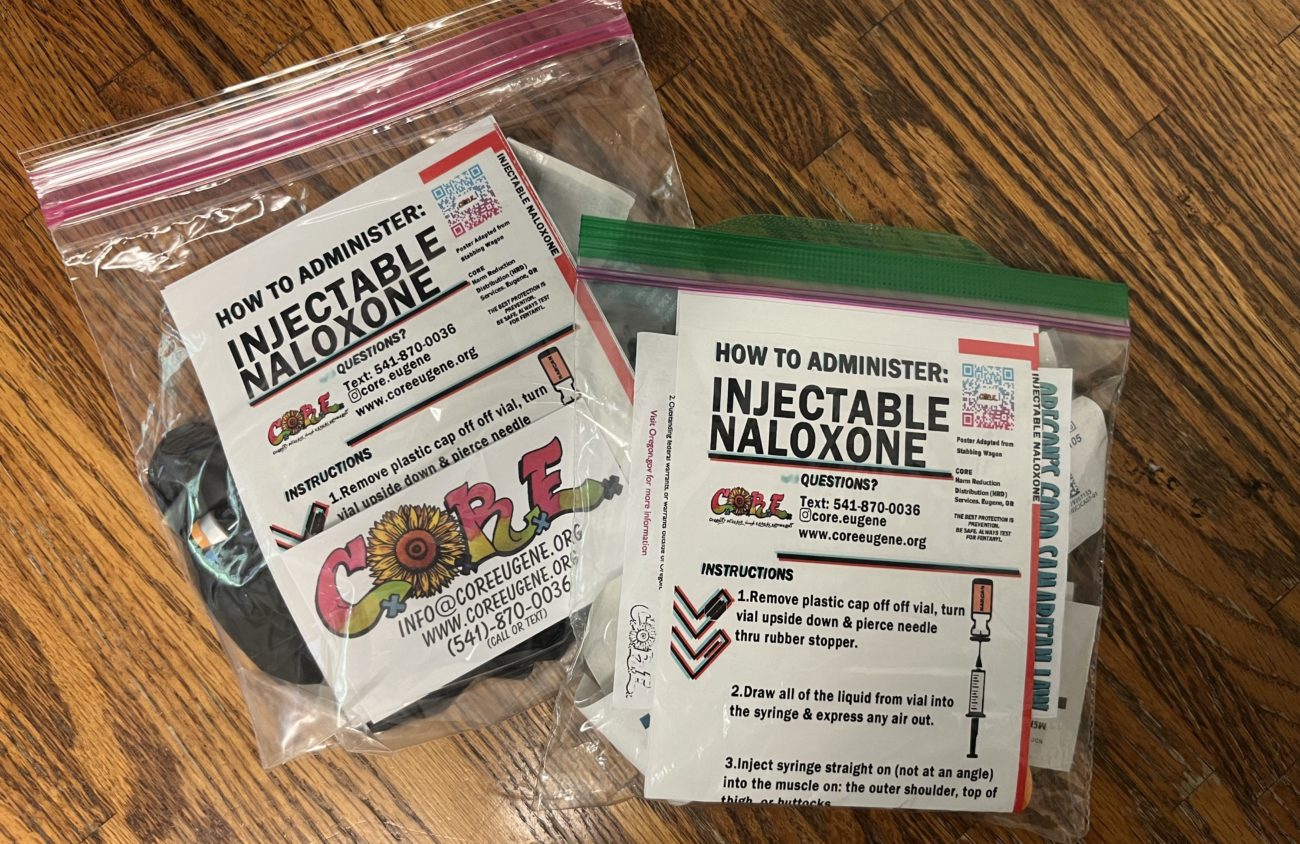Drug overdoses have reached an all time high; the Center for Disease Control reported that during a 12 month period ending in April of 2021, the U.S. reached a record of 100,306 overdose deaths. Eugene’s HIV Alliance reported that this trend has been observed in Lane and other Oregon counties. Local organizations like HIV Alliance and CORE — Community Outreach through Radical Empowerment — are working to reduce overdoses by providing harm reduction resources.
Overdoses in Oregon have primarily increased due to increased fentanyl in drug supplies. Fentanyl is a synthetic opioid that is often added to a drug without the consumer’s knowledge; the Oregon Health Authority reports that between 2019 and 2020, fentanyl-related overdoses increased by over 300 percent in the state.
Naloxone, commonly available under the brand Narcan, is an FDA-approved medication designed to reverse the effects of an opioid overdose. This nasal spray medication is potentially life saving, and it goes to work within seconds of consumption. The synthetic drug blocks opiate receptors in the nervous system. Naloxone only works for opioid drugs, which include heroin, morphine, oxycodone, oxymorphone, methadone, hydrocodone, codeine and fentanyl, according to the Oregon Health Authority.
Oregon law allows for any person to obtain the medication at a pharmacy, and for any person to carry and use naloxone on others. The state’s Good Samaritan Law says if someone is overdosing, no one can be charged for violating drug laws when seeking medical help. If people can’t get the medication at a pharmacy, HIV Alliance and CORE are among groups offering naloxone to residents and passers-by as part of harm reduction services.
HIV Alliance describes harm reduction as a way to reduce potential harm from actions that are taken; harm reduction in terms of drug use aims to reduce negative consequences. It is an evidence-based approach to drug use. Renne Yandel, HIV Alliance executive director says that in the past year more than 1,000 reversals using naloxone among their clients were reported. HIV Alliance provides the resource free of charge.
“That means potentially 1,000 lives saved,” Yandel says. “And I think this is like an important kind of stigma-busting point that, you know, that person used Narcan to save their friend’s life.”
CORE is a service in Eugene for young people. CORE has street outreach weekly, where they carry an array of different harm reduction supplies — including naloxone. Brittiny Raine, CORE co-creator and co-executive director, says that feedback from the young community living on the streets in Eugene inspires her and CORE to respond accordingly. CORE’s street outreach and harm reduction services allow those aged 14-29 to obtain free naloxone.
“We believe that young people are the experts in their lives,” Raine says. “And we’re there to help them eliminate barriers to reaching their goals. We don’t prescribe what their goal should be, but I feel like we are safe community members in their life.”
CORE also looks to erase the stigma associated with drug-use and overdose, and to provide services for safer usage.
An overdose might look like slow or no breathing, choking sounds, discolored skin, vomiting, decreased level of consciousness, no response to stimuli, limp body, unable to speak, and pinpoint pupils, according to the American Addiction Center.
International Overdose Awareness Day is observed annually on August 31. HIV Alliance, HIVAlliance.org, will provide free overdose prevention training sessions on August 31 through Zoom at 10 am, noon, 2 and 4 pm.
Yandel says that these events are important for community members to learn about what an overdose looks like, and what can be done about it. These trainings are open to anyone and will provide information on identifying an overdose and administering naloxone.
The naloxone flier in CORE Eugene’s kits was designed by Steven Essig. For those interested in the open source, editable pdf of the naloxone introduction fliers as seen in the photo they are available in English and Spanish with color and black & white options. They are free. Email Stabbin Wagon at weenlissa@gmail.com.
A gathering at Monroe Park on Monroe Street and West 11 Ave. to remember individuals who have died from overdoses and provide naloxone resources is noon to 3 pm Wednesday, August 31.
Help keep truly independent
local news alive!
As the year wraps up, we’re reminded — again — that independent local news doesn’t just magically appear. It exists because this community insists on having a watchdog, a megaphone and occasionally a thorn in someone’s side.
Over the past two years, you helped us regroup and get back to doing what we do best: reporting with heart, backbone, and zero corporate nonsense.
If you want to keep Eugene Weekly free and fearless… this is the moment.
